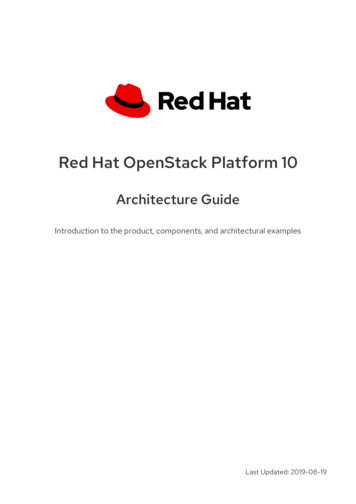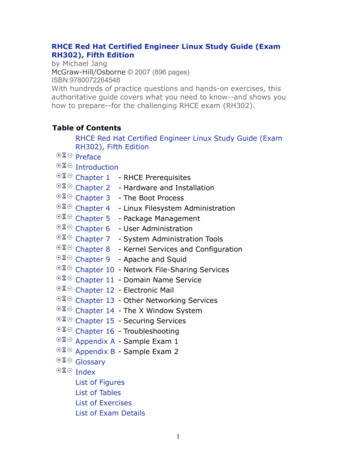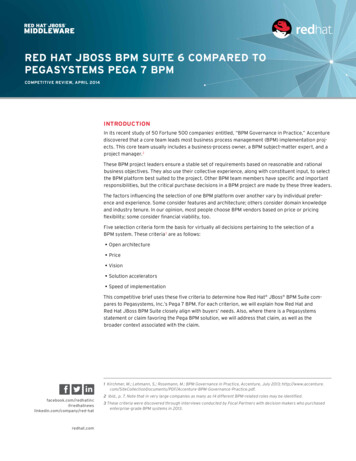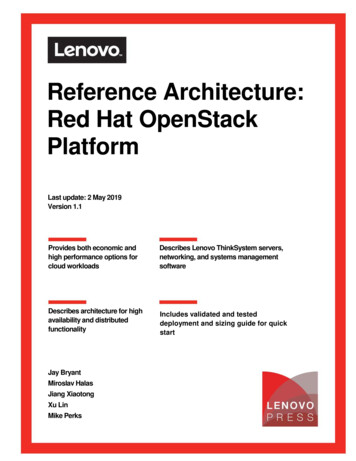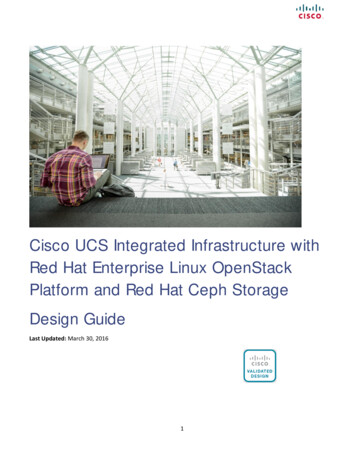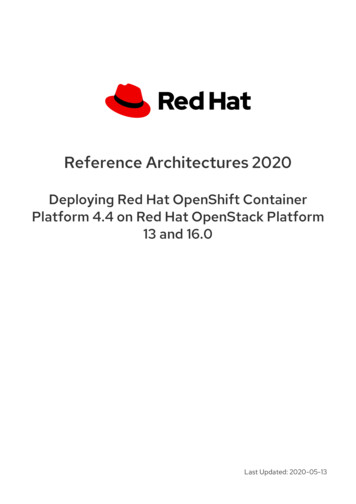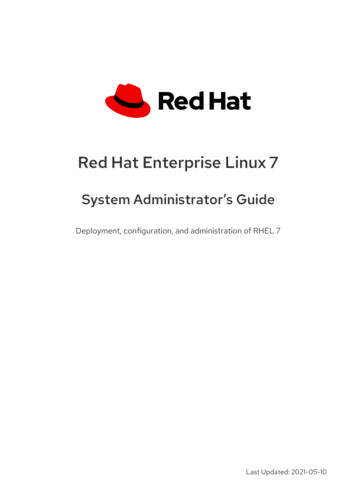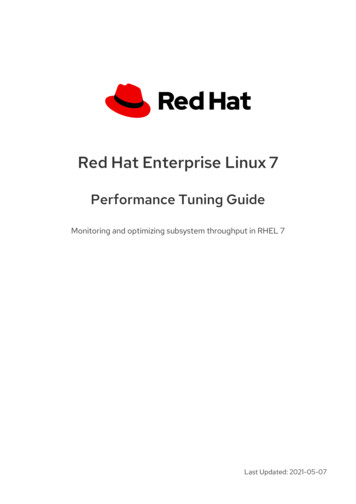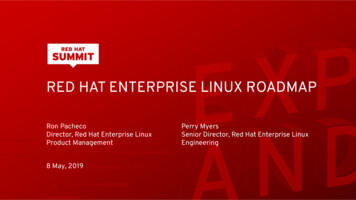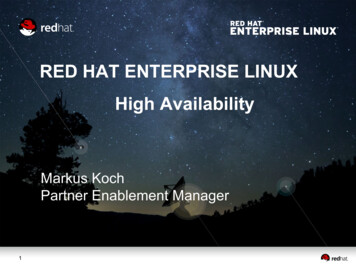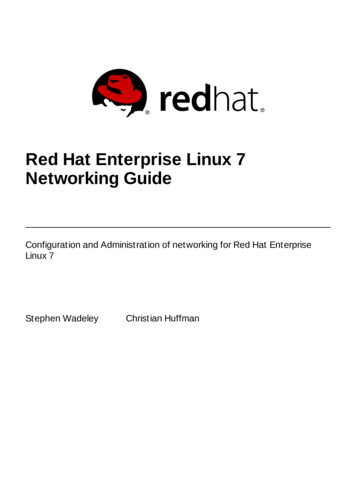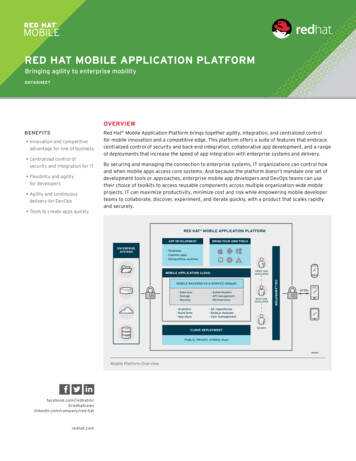
Transcription
RED HAT MOBILE APPLICATION PLATFORMBringing agility to enterprise mobilityDATASHEETOVERVIEWBENEFITS I nnovation and competitiveadvantage for line of business C entralized control ofsecurity and integration for IT F lexibility and agilityfor developers A gility and continuousdelivery for DevOps Red Hat Mobile Application Platform brings together agility, integration, and centralized controlfor mobile innovation and a competitive edge. This platform offers a suite of features that embracecentralized control of security and back-end integration, collaborative app development, and a rangeof deployments that increase the speed of app integration with enterprise systems and delivery.By securing and managing the connection to enterprise systems, IT organizations can control howand when mobile apps access core systems. And because the platform doesn’t mandate one set ofdevelopment tools or approaches, enterprise mobile app developers and DevOps teams can usetheir choice of toolkits to access reusable components across multiple organization-wide mobileprojects. IT can maximize productivity, minimize cost and risk while empowering mobile developerteams to collaborate, discover, experiment, and iterate quickly, with a product that scales rapidlyand securely. Tools to create apps quicklyRED HAT MOBILE APPLICATION PLATFORMAPP DEVELOPMENTENTERPRISESYSTEMSBRING-YOUR-OWN-TOOLS· Templates· Codeless apps· Online/offline workflowFRONT ENDDEVELOPERMOBILE APPLICATION CLOUD· Data sync· Storage· Security· Analytics· Build farm· App store· Authentication· API management· MicroservicesBACK ENDDEVELOPERCOLLABORATIONMOBILE BACKEND-AS-A-SERVICE (MBaaS)HTTPs· Git repositories· Node.js modules· User managementCLOUD DEPLOYMENTDEVOPSPUBLIC, PRIVATE, HYBRID, PaaSJB00102Mobile Platform com/company/red-hatredhat.com
FEATURESKey features of Red Hat Mobile Application Platform include: Back-end integration Security and authentication Collaboration and application life-cyclemanagement Front-end development tools Cloud and on-premise deployment Rapid mobile application development1. BACK-END INTEGRATIONFEATURE HIGHLIGHTSFEATUREBENEFIT Open, extensible architecturebased on Node.jsMobile Backend-as-a-Service(MBaaS)Based on open technologies and Node.js, MBaaS capabilities providea high-performance, lightweight framework, allowing mobile developers to securely integrate mobile apps with back-end systems. AnMBaaS manages data storage, scaling, notifications, analytics, andmore between device and back-end systems. This allows mobile developers to focus on the app, playing a critical role in enterprise mobile appenablement. It comes with ready-to-use modules for common back-endsystems such as Salesforce, Sharepoint, and Oracle.Microservices and application programming interfaces(APIs)The architecture is based on microservices and RESTful APIs.Developers can create microservices and back-end APIs in Node.js thatcan be reused across multiple mobile projects by multiple developmentteams, eliminating the need to recreate complex back-end connections. They can also create microservices specific to a mobile use caseto optimize the information from back-end systems for mobile devices,leading to better, more efficient app design.Node.js modulesDevelopers are free to create back-end services using Node.js modules.They can also create new microservices by accessing module snippetsthrough the npmjs.org community.Data syncThe data sync framework allows developers to include offline functionality in their mobile solutions. It provides a mechanism to managebidirectional data synchronization from multiple client apps intoback-end systems with the capability to manage data collisionsfrom multiple updates. Enterprise-grade MBaaS Standard developer toolkitsand frameworks Team and collaborationfeatures Mobile app life-cyclemanagement Rapid mobile app development (RMAD) tools Templates andcustomizable solutions App managementand reporting Hosted, private cloud, andon-premise deployment2. SECURITY AND curity begins on the device with the optional use of AES/RSA APIsfor encryption of locally cached data, followed by HTTPS protocol fromthe app to the MBaaS. Additional security is provided by the ability toadd an API key per application. A set of authentication APIs makes iteasy to implement authentication with session management.DATASHEETRed Hat Mobile Application Platform2
FEATUREBENEFITProtecting access toback-end systemsAccess from the MBaaS to back-end systems can be secured in accordance with the organization’s security policies. This includes the useof IP address punch-through, fully configured site-to-site VPNs, strongfirewalls, demilitarized zones (DMZs), approved datacenters, approveddatacenter locations, on-premise deployment, and more.User authentication andauthorizationUser security and authentication can be managed through user credentials or a user’s own LDAP/Active Directory system. OAuth integration isalso available for third-party services. Single sign-on (SSO) with vendorspecific offerings can also be implemented.3. COLLABORATION AND APPLICATION LIFE-CYCLE MANAGEMENTFEATUREBENEFITTeam- and role-basedcollaborationDevelopment teams, both in-house and outsourced, composed ofdifferent skills—UI/UX design, front-end coding, back-end servicesdevelopment, administration, DevOps, and more—can work concurrently on multiple app projects without impacting individual developeragility.Access controlConfiguration of fine-grained controls at all levels of each mobile projectfacilitates secure access to key project and product components. Thishelps lock down functionality at different levels within the platform.It also encourages an API-driven and microservices developmentapproach, enabling ease of discovery and reusability.Mobile application life-cyclemanagement (ALM)Time-to-market for mobile projects puts DevOps teams under pressureto manage multiple iterative app releases. Mobile ALM allows configuration and management of multiple project environments (e.g., development, test, pre-production, production) incorporating the accesscontrol features of collaboration.Developer workflowBy giving every application and cloud back end within a project its ownGit repository, a coordinated workflow is a reality. Git supports sourcecode version control and collaboration, allowing multiple developers towork on the same code in parallel.4. FRONT-END DEVELOPMENT TOOLSredhat.comFEATUREBENEFITOpen and flexible toolkitsDevelopers are more productive with freedom to use their choiceof tools, including any integrated development environment (IDE)for hybrid and native mobile app development. Support is providedfor native software development kits (SDKs) (iOS, Android, WindowsPhone), hybrid Apache Cordova, HTML5 and Appcelerator, as well asXamarin, Sencha, React, Ionic, Backbone.js, Angular.js, Ember.js, andJBoss Developer Studio.DATASHEETRed Hat Mobile Application Platform3
FEATUREBENEFITJBoss Developer StudioAn Eclipse IDE for building mobile apps for all major operating systemsvia Apache Cordova. Integrated with the mobile platform, JBossDeveloper Studio provides organizations with a fully supported development environment. This includes productivity tools such as UIelement palettes and quick-start projects for popular frameworks likeIonic, Angular.js, and Backbone.js.Application migrationExisting mobile applications can be migrated and centrally managed.Whether it’s native, HTML5, or hybrid applications, code is not lost.Credentials and certificates are centralized and updates can be transferred from one team to another.Online/offline workflowDevelopers are free to work locally in their own environment or in thehosted studio with access to collaboration, MBaaS features, reusablecode, templates, APIs, shared services, and more.Multidevice buildsThe hosted build farm service supports builds for native and hybridapplications for iOS, Android, and Windows Phone, generating build anddigital signatures. This eliminates the need to maintain device-specifichardware/software environments to build new applications.Credential storageDevelopers can store credential bundles for building debug, test, andproduction apps across all platforms. This provides a single repositoryfor signing credentials independent of the developer’s local machine.For organizations with large in-house or external development teams,this simplifies the management of signing credentials and future appupdates.5. RAPID MOBILE APPLICATION DEVELOPMENTredhat.comFEATUREBENEFITMobile forms builderFast results can be achieved from quickly transforming paper-basedprocesses to mobile forms. Apps can be quickly created, withoutwriting code, with the ease of a mobile forms builder. This low-codeapproach to building apps is also an excellent option for prototyping ideas and extending existing back-end applications with formscapabilities.TemplatesTo kick-start the creation of new mobile app projects, the ready-to-usesample and template apps provide the fundamentals of building cloudpowered mobile apps and back-end integrations.Field workforce management(WFM) modulesField WFM modules are open source components designed for organizations building mobile apps for field operations. They can be used tocustomize features to support workflow of job orders, scheduling, andmanagement of field workers on mobile devices.DATASHEETRed Hat Mobile Application Platform4
DATASHEETRed Hat Mobile Application Platform6. CLOUD AND ON-PREMISE DEPLOYMENTFOR MORE INFORMATIONON RED HAT MOBILECONTACT:FEATUREBENEFITHosted deploymentRed Hat Mobile Application Platform is a cloud-agnostic architectureand offers a wide range of cloud deployments to suit any enterpriserequirement. Public cloud hosting offers affordability and reasonableservice level agreements (SLAs). For highly sensitive mobile workloadsand high availability requirements, organizations can considerdedicated clouds or hybrid cloud environments that offer the best ofboth worlds. mobile@redhat.com NA: 1 919 754 4400 EU: 44 20 3393 1466Cloud hosting options include: www.redhat.com/mobile Public multitenant Private, dedicated and managed@RedHatMobile Hybrid, the application cloud code (dedicated MBaaS) can reside inother cloudslinkedin.com/company/feedhenryOn-premise .com/channel/UCYvKWvC7UoUXyLcb16doD3gTaking advantage of the capabilities of Red Hat Enterprise Linux andOpenShift Enterprise by Red Hat, Red Hat Mobile Application Platformcan be deployed in traditional on-premise scenarios where the organization manages the platform. This facilitates a greater degree of datamanagement, as all data from back-end systems will pass through anorganization’s infrastructure on its way to the mobile device.ABOUT RED HATRed Hat is the world’s leading provider of open source software solutions, using a community-poweredapproach to provide reliable and high-performing cloud, Linux, middleware, storage, and virtualizationtechnologies. Red Hat also offers award-winning support, training, and consulting services. As aconnective hub in a global network of enterprises, partners, and open source communities, Red Hathelps create relevant, innovative technologies that liberate resources for growth and prepare customersfor the future of ompany/red-hatredhat.comINC0424620 v4 0716NORTH AMERICA1 888 REDHAT1EUROPE, MIDDLE EAST,AND AFRICA00800 7334 2835europe@redhat.comASIA PACIFIC 65 6490 4200apac@redhat.comLATIN AMERICA 54 11 4329 7300info-latam@redhat.comCopyright 2016 Red Hat, Inc. Red Hat, Red Hat Enterprise Linux, the Shadowman logo, and JBoss are trademarks of Red Hat, Inc.,registered in the U.S. and other countries. Linux is the registered trademark of Linus Torvalds in the U.S. and other countries.
Red Hat Mobile Application Platform brings together agility, integration, and centralized control for mobile innovation and a competitive edge. This platform offers a suite of features that embrace . Sharepoint, and Oracle. Microservices and applica - tion programming interfaces (APIs) T
